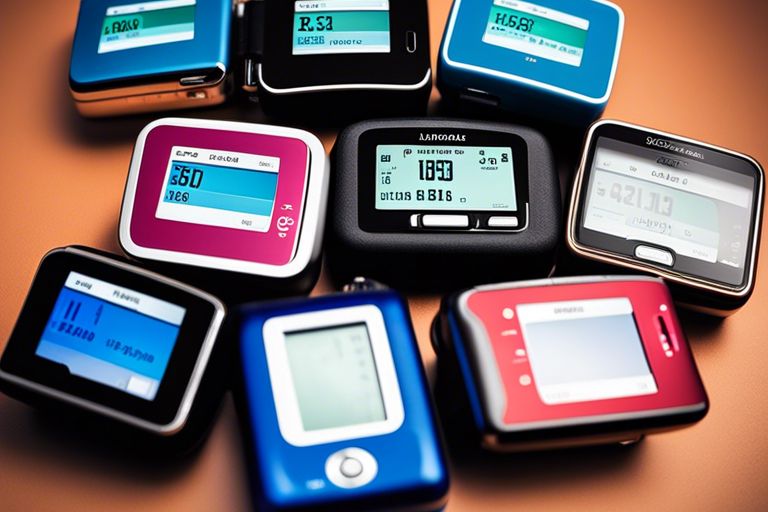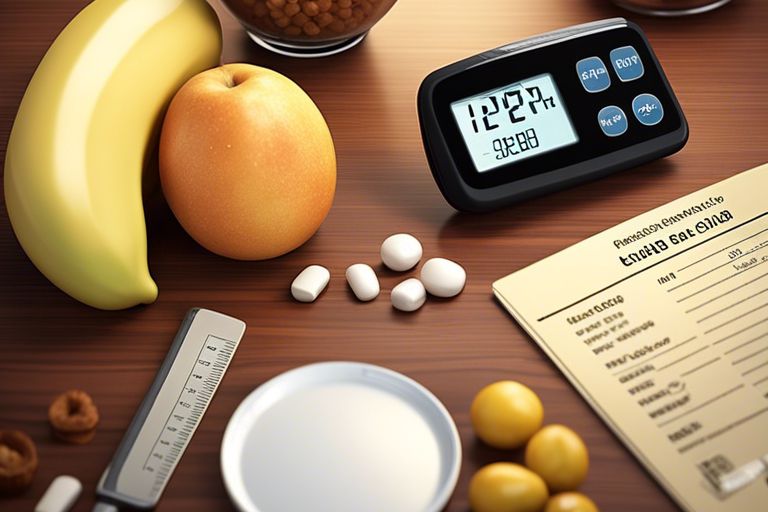Fostering a well-rounded and nourishing diet can be pivotal in managing Type 1 Diabetes effectively. Crafting a balanced meal plan tailored to the specific needs of individuals with Type 1 Diabetes requires meticulous attention and expert guidance. In this comprehensive guide, we will research into the key components of a successful meal plan, outlining essential tips and strategies to help you navigate the complexities of diabetes management through informed dietary choices. Let’s initiate on this journey towards better health and improved well-being together.
Key Takeaways:
- Consult a Registered Dietitian: Meeting with a registered dietitian can help you create a personalized meal plan that accounts for your individual needs and preferences.
- Include a Variety of Foods: A balanced meal plan for type 1 diabetes should include a variety of nutrient-dense foods such as fruits, vegetables, lean proteins, whole grains, and healthy fats.
- Monitor Carbohydrate Intake: Carbohydrates have the most significant impact on blood sugar levels, so it is crucial to monitor and distribute your carbohydrate intake throughout the day.
- Pay Attention to Portion Sizes: Portion control is essential for managing blood sugar levels, so be mindful of serving sizes and try to eat at regular intervals throughout the day.
- Stay Hydrated: Proper hydration is essential for overall health and can also help regulate blood sugar levels, so make sure to drink plenty of water throughout the day.
Essential Components of a Diabetes-Friendly Meal
Macronutrient Balance: Carbohydrates, Proteins, and Fats
One of the essential components of creating a balanced meal plan for individuals with type 1 diabetes is understanding the importance of macronutrient balance. Carbohydrates, proteins, and fats play a crucial role in managing blood sugar levels and overall health for individuals with diabetes.
Essential to the meal plan is knowing how each macronutrient affects blood glucose levels. Carbohydrates have the most significant impact on blood sugar, while proteins and fats have a more moderate effect. Balancing these macronutrients in each meal can help stabilize blood sugar levels and provide sustained energy throughout the day.
The Role of Fiber and Its Impact on Blood Sugar
Balance in a diabetes-friendly meal plan also involves incorporating adequate fiber intake. Fiber is a type of carbohydrate that the body cannot digest, so it does not raise blood sugar levels. Including high-fiber foods such as fruits, vegetables, whole grains, and legumes can help regulate blood sugar levels and improve overall gut health.
With its ability to slow down the absorption of sugar, fiber can prevent spikes in blood glucose levels after meals. Additionally, fiber-rich foods can promote a feeling of fullness and aid in weight management, which is crucial for individuals with type 1 diabetes in maintaining a healthy weight and preventing complications.
Factors to Consider When Creating Your Meal Plan
Clearly, managing type 1 diabetes requires careful planning and consideration when it comes to your meal plan. There are several factors that need to be taken into account to ensure that your meals are balanced and in line with your nutritional needs.
- Consider your daily caloric and carbohydrate needs
- Take into account the glycemic index and glycemic load of foods
- Think about the timing of your meals and snacks
- Balance your macronutrients (carbohydrates, protein, and fat)
- Choose nutrient-dense foods to meet your micronutrient needs
Assume that by carefully considering these factors, you can create a meal plan that helps you manage your blood sugar levels effectively and supports your overall health and well-being.
Calculating Daily Caloric and Carbohydrate Needs
Creating a balanced meal plan for type 1 diabetes starts with understanding your individual daily caloric and carbohydrate needs. These needs can vary based on factors such as age, weight, activity level, and insulin sensitivity. Consult with a registered dietitian or healthcare provider to determine the right balance that works for you.
It’s essential to strike a balance that provides enough energy for your daily activities while keeping your blood sugar levels stable. Tracking your food intake, blood sugar levels, and insulin doses can help you fine-tune your meal plan over time to achieve optimal control.
The Importance of Glycemic Index and Glycemic Load
The glycemic index (GI) and glycemic load (GL) of foods play a crucial role in managing blood sugar levels for individuals with type 1 diabetes. The GI measures how quickly a carbohydrate-containing food raises blood sugar levels, while the GL takes into account both the quality and quantity of carbohydrates in a food.
The choices you make regarding the types of carbohydrates you consume can have a significant impact on your blood sugar control. Foods with a lower GI and GL are digested more slowly, leading to a more gradual rise in blood sugar levels. This can help prevent spikes or crashes in blood sugar and promote better overall glycemic control.
Your healthcare provider or dietitian can help you identify low-GI and low-GL options and integrate them into your meal plan to support stable blood sugar levels throughout the day.
Tips for Meal Planning and Preparation
Despite the challenges that come with managing type 1 diabetes, meal planning and preparation can be key to maintaining stable blood sugar levels. By carefully selecting nutritious foods and monitoring portion sizes, individuals can create a balanced meal plan that meets their dietary needs.
- Include a variety of foods such as lean proteins, whole grains, fruits, vegetables, and healthy fats in each meal.
- Measure and portion out your food to help regulate blood sugar levels throughout the day.
- Plan meals in advance to ensure you have healthy options readily available and reduce the temptation to make impulsive food choices.
Recognizing the importance of consistency in meal planning and preparation can help individuals with type 1 diabetes effectively manage their condition and improve their overall health.
How to Read Food Labels and Measure Portions Accurately
Read food labels carefully to understand the nutritional content of the foods you consume. Pay attention to serving sizes, carbohydrate counts, and sugar content to make informed choices about what to include in your meals. Use measuring tools such as cups, spoons, and food scales to accurately portion out your food and track your carbohydrate intake.
By accurately measuring your portions and understanding food labels, you can better control your blood sugar levels and make adjustments to your meal plan as needed. This level of precision can help you create a balanced diet that supports your overall health and well-being.
Smart Grocery Shopping and Meal Prep Strategies
Food plays a crucial role in managing type 1 diabetes, so it’s essential to shop smart and plan ahead to maintain a healthy diet. When grocery shopping, focus on selecting fresh produce, lean proteins, whole grains, and low-fat dairy products. Choose foods that are high in fiber and low in added sugars to support stable blood sugar levels.
Accurately planning and prepping your meals can save you time and ensure that you have nutritious options available when hunger strikes. By organizing your kitchen, stocking up on healthy ingredients, and preparing meals in advance, you can make it easier to stick to your meal plan and avoid unhealthy food choices.
Overcoming Challenges and Adjusting Your Meal Plan
Not every day will be smooth sailing when managing type 1 diabetes, but being prepared to adjust your meal plan can help you navigate through unexpected challenges. Understanding how to cope with fluctuations in blood sugar levels and adapting your meal plan for exercise and special occasions are key aspects of maintaining a balanced and healthy lifestyle.
Coping with Hypoglycemia and Hyperglycemia
Meal planning plays a crucial role in managing hypoglycemia (low blood sugar) and hyperglycemia (high blood sugar) for individuals with type 1 diabetes. To prevent hypoglycemia, ensure that your meals contain a balance of carbohydrates, proteins, and fats. In the case of an episode of hypoglycemia, have quick-acting glucose sources like fruit juice or glucose tablets readily available to raise your blood sugar levels rapidly.
Adapting Your Meal Plan for Exercise and Special Occasions
Meal planning for exercise and special occasions requires a strategic approach to maintain stable blood sugar levels. Before engaging in physical activity, consider adjusting your carbohydrate intake to match the intensity and duration of the exercise. Additionally, plan your meals and snacks around the timing of the activity to prevent blood sugar fluctuations. When attending special occasions, be mindful of portion sizes and opt for healthier choices to keep your blood sugar in check.
Hypoglycemia can be a concern when participating in physical activities or during special events. It is essential to monitor your blood sugar levels regularly and have snacks on hand to address any fluctuations promptly. By staying proactive and making necessary adjustments to your meal plan, you can manage type 1 diabetes effectively and enjoy a balanced lifestyle.
Summing up
Creating a balanced meal plan for individuals with type 1 diabetes is essential to managing blood sugar levels and overall health. By following the expert guide provided here, it is possible to design a meal plan that includes a variety of nutrients while managing carbohydrate intake. Remember to work closely with a healthcare provider or a registered dietitian to personalize the meal plan based on individual needs and preferences. With the right approach, individuals with type 1 diabetes can maintain stable blood sugar levels and improve their overall well-being through a well-balanced diet.
FAQ
Q: Why is it important for individuals with type 1 diabetes to follow a balanced meal plan?
A: Following a balanced meal plan is crucial for individuals with type 1 diabetes to help manage blood sugar levels, maintain overall health, and prevent complications associated with the condition.
Q: What should a balanced meal plan for type 1 diabetes include?
A: A balanced meal plan for type 1 diabetes should include a mix of carbohydrates, protein, and healthy fats. It’s important to choose whole foods such as fruits, vegetables, whole grains, lean proteins, and heart-healthy fats.
Q: How can individuals with type 1 diabetes determine the appropriate portion sizes for meals?
A: It’s important for individuals with type 1 diabetes to work with a registered dietitian or healthcare provider to determine appropriate portion sizes based on their individual needs, activity level, and blood sugar goals.
Q: Are there any specific food groups that individuals with type 1 diabetes should limit or avoid?
A: While there are no specific foods that individuals with type 1 diabetes need to completely avoid, it’s important to limit processed foods, sugary drinks, and foods high in saturated fats. Monitoring portion sizes and carbohydrate intake is also essential.
Q: How can individuals with type 1 diabetes ensure they are meeting their nutritional needs with a balanced meal plan?
A: To ensure nutritional needs are met, individuals with type 1 diabetes should focus on variety in their food choices, monitor blood sugar levels regularly, and consider incorporating supplements if needed. Consulting with a healthcare team can help fine-tune a meal plan to meet specific needs.




